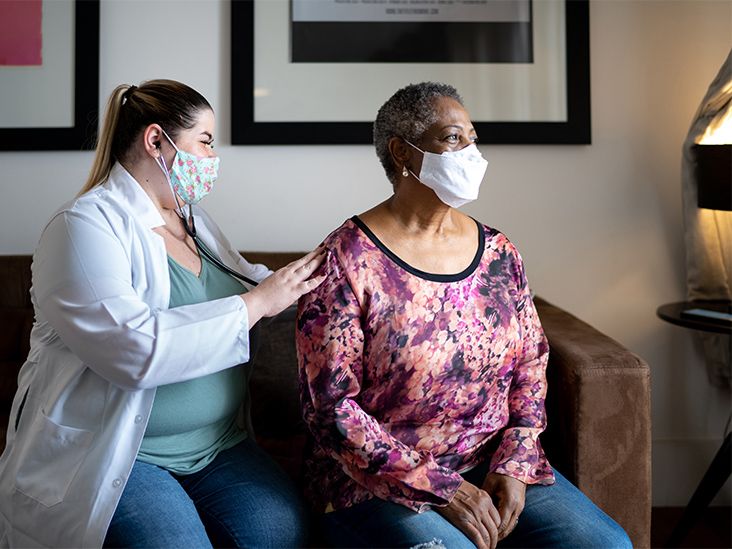COPD cannot be reversed. However, quitting smoking, managing any allergies, and following an exercise program may help slow its progression.
Chronic obstructive pulmonary disease (COPD) is a group of lung diseases that diminish airflow from the lungs, making breathing difficult. It includes emphysema and chronic bronchitis.
Common symptoms include:
- chronic cough that produces mucus
- decreased ability to exercise
- shortness of breath
- frequent respiratory infections
Read on to learn how lifestyle habits can affect your quality of life and your outlook with COPD.
While it’s not possible to reverse COPD, it is possible to treat the symptoms. Treatment, such as medications and pulmonary rehabilitation,
Can COPD be reversed by quitting smoking?
Smoking is responsible for COPD in around 75% of cases.
If your COPD results from smoking cigarettes, the best thing you can do is try to quit smoking. This helps slow the progression of the condition and makes your body be more receptive to treatment.
While it cannot reverse COPD, quitting can decrease inflammation of your respiratory tract and improve your immune system.
Quitting smoking can be difficult, but resources are available to help you achieve this goal, including:
- phone apps
- personal coaches
- support groups
You can learn more about how to quit smoking.
Can COPD be reversed by avoiding exposure to chemicals and pollutants?
While it cannot reverse COPD, avoiding environmental factors that can irritate your lungs can help you feel better and slow COPD progression. These include:
- air pollution
- smoke from wildfires and burning wood
- pollution from factories
- chemicals, dust, and fumes
Using an air purifier to improve air quality may also help your breathing.
It’s also important to manage any allergies you have that cause breathing problems. Avoiding known allergens, such as animal dander and pollen, and taking the appropriate medications can decrease breathing difficulties.
Can you reverse COPD with exercise?
Exercise can improve the way you feel, breathe, and function. Although
Most people with COPD experience shortness of breath, which can make it hard to perform day-to-day tasks or engage in physical activity. But without exercise, your muscles weaken, and your heart and lungs become less tolerant of activity, making exercising tougher.
To help prevent this, it’s important to stay active. Take it slowly until you’ve built up your strength, but make sure you’re moving.
Pulmonary rehabilitation programs can be useful for learning about exercises that can improve your tolerance for activity and increase your independence. You can ask your doctor about programs in your area.
Before you start exercising, talk with your doctor. They can help you develop an exercise plan to fit your needs.
If you use oxygen, your doctor can guide you on best practices for using it while exercising. You may need to adjust your oxygen flow rate to accommodate increased activity.
Once you’ve gotten into a routine, you can gradually increase your exercise time and effort. Doing more each day can help you build up your endurance and improve your quality of life.
A general goal is to exercise 3 to 4 days per week. It’s OK to start by doing 10- to 15-minute sessions. If you can, work up to 30 to 40 minutes per session.
Learn more about exercising with COPD and adapting exercises for COPD.
COPD is a chronic disease. While it’s possible to slow the progression, symptoms will eventually worsen.
Experts classify COPD into various grades to help you and your doctor understand your disease state and decide on a treatment plan.
GOLD staging
The Global Initiative for Chronic Obstructive Lung Disease (GOLD) grades the severity of airflow obstruction based on your FEV1 value, the amount of air you can force from your lungs in 1 second.
GOLD grade 1: Mild
Grade 1 means that your FEV1 is at least 80% of what’s expected.
GOLD grade 2: Moderate
Grade 2 means that the disease has progressed to moderate COPD. Your FEV1 is 50% to 79% of what’s expected.
GOLD grade 3: Severe
Grade 3 is defined as severe COPD. Your forced lung function is 30% to 49% of what’s expected.
GOLD grade 4: Very severe
This is the most severe grade of COPD. Your forced lung function is less than 30% of what’s expected.
A, B, E score
Lung function isn’t the only important aspect of COPD. Doctors now realize it’s necessary to understand how COPD flares and other symptoms, such as cough, breathlessness, and sleep quality, affect daily life.
To assess this, the GOLD grade receives an additional score of A, B, or E.
An A score is associated with the fewest symptoms and flares, while an E score is associated with the most.
Recommendations for treatment come from both the lung function grade and the severity of symptoms, or letter score.
Early diagnosis is key. Shortness of breath and an ongoing cough are the most common reasons people seek medical attention before receiving a COPD diagnosis.
As the disease progresses, people notice worsening symptoms such as:
- breathlessness
- chest tightness
- wheezing
- increased phlegm
In a later grade of COPD, people typically experience all these symptoms along with loss of appetite, weight loss, and fatigue.
Usually, the sooner COPD is diagnosed, the
In people with COPD who smoke and do not quit, the condition progresses more quickly and shortens life expectancy.
How do you stop COPD from progressing?
There’s currently no way to stop COPD from progressing.
While you cannot reverse lung damage from COPD, you may be able to take steps to treat the symptoms and slow the progression.
Is it possible for COPD to get better?
While you can manage some symptoms of COPD, it’s not possible to stop them completely or reverse the disease.
However, treatment, including pulmonary rehabilitation, may help relieve some of your symptoms and help you breathe better.
What is the life expectancy of COPD?
On average, COPD reduces your life expectancy by 8 to 9 years.
However, research among people with a moderate grade of COPD suggests life expectancy is lowered by 6.2 years. Making lifestyle changes and getting treatment may help slow the progression.
Is COPD classed as a ‘terminal illness’?
There is no cure for COPD or a way to reverse COPD lung damage. The disease is progressive, meaning that it worsens over time.
However, many people with mild to moderate COPD live for many years with the disease, especially if they take steps to slow the disease progression, including following treatment guidelines and reducing exposure to triggers.
If you have severe COPD, doctors can recommend treatments to help reduce your symptoms and improve your quality of life. They may also recommend surgery for some people.
If you have any grade of COPD, you can also consider palliative care, which focuses on minimizing symptoms while helping you manage the emotional aspects of living with a severe illness.
Note that palliative care is different from hospice care in that it’s available to all people with severe illness and not only those who may be passing away soon.
In addition to avoiding smoking and limiting your exposure to other harmful irritants, you can take other steps to reduce COPD complications and progression.
Eating a balanced diet and getting regular exercise can help strengthen your immune system and build up your endurance.
You may also find it helpful to make changes around your home. This may mean keeping items you use daily on a common table or moving items from a top shelf to somewhere easier to access.
Making a few changes can help conserve energy and avoid overexerting yourself.
Follow your doctor’s treatment recommendations. If you’re feeling unwell or believe your symptoms are worse than before, let your doctor know. They can evaluate your treatment plan and make adjustments as needed.








